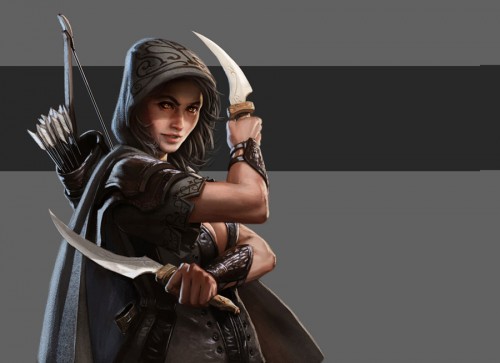Depending on your background and tastes, there are many places where Dungeons & Dragons may have taken a bad turn. For some it’s when weapon speeds and casting times were thrown out. For others it was when spellcasters got useful abilities they could use all day every day. Others feel the whole game was misconceived from start to finish and it’s just plain thoroughly bad.
Let’s take a look at the original four-person adventuring party: The Fighting Man, the Magic User, the Priest, and the Thief. What’s wrong with this list? The Thief. This wasn’t originally part of OG D&D. When you’re looking to play a bunch of tomb-raiding murderhobos delving through dungeons, slaying monsters, and taking all their stuff, isn’t everybody a lowercase-t thief? Who is responsible for finding traps? Everybody. Who is responsible for locating and bypassing perilous traps? Everybody. By introducing the Thief as a separate class, more recently called the Rogue, you take some of the core functionality of the other classes away from them to build a special little Thief-shaped niche in the genre that doesn’t belong there. Why should Conan the Cimmerian have to switch character classes midway through his career? He didn’t suddenly become a master of the arcane arts or the chosen miracle-worker of some god or other. He was an adventuring Fighting Man straight through his career, whether as a savage tribesman, pirate, mercenary, or urban thief.
So how about we just straight-up kill the Rogue as a character class and give its goodies back to those with whom they belong: everybody. In Type 5 Dungeons & Dragons, the Rogue is a middle-sized hit die character with four skill proficiencies instead of two that gains access to sneak attacks, cunning bonus actions, and some skill perks. Its subclasses are the Thief, the Assassin, and the Arcane Trickster. Thief gains benefits that, as discussed above, should be available to just about everybody. The Assassin is every bit as bad of a character class concept as Thief; a murderer for hire is an assassin. Whether this is accomplished by poison, steel, or spells the person is still a lowercase-a assassin. Really this is just a sneak attack specialist. We’ll keep that in mind. The arcane trickster is just a Wizard that’s a dick about other folks’ private property. We can probably ditch that outright. Get your Wizard Sleight of Hand proficiency and call it a day.
Let’s take a look at what to do with all these class features:
- Saving Throws: leave them be. Everybody else already has two proficiencies here.
- Proficiencies: Grant three skill proficiencies to every class that doesn’t include full (1st – 9th level) spell progression.
- Expertise: Grant Expertise to a single skill to every class that doesn’t include full (1st – 9th level) spell progression. All character classes (including full casters) may select an additional skill to have Expertise in at 6th level.
- Sneak Attack: Grant Sneak Attack to every class. Full casters get 1/3rd their character level from the existing Rogue table, everybody else gets 1/2 character level.
- Thieve’s Cant: This is dumb and shouldn’t be included in anybody’s game. Drop it.
- Cunning Action: Grant Cunning Action to everybody, with the following modification. The bonus action can be used only to perform a task directly related to a skill you have Expertise in. Disengage is related to Acrobatics, Dash is related to Athletics, Hide is related to Stealth.
- Roguish Archetype: At 3rd level a character that has not already selected an Oath, Domain, Archetype, or other subclass may add Assassin to the list of subtypes available. A character selecting Assassin gains Sneak Attack at full class level on the Rogue table, in addition to the benefits of the Assassin archetype.
- Uncanny Dodge: Starting at 5th level, whenever your character class or subclass grants you a new feature, you may select Uncanny Dodge instead.
- Evasion: Starting at 7th level, whenever your character class or subclass grants you a new feature, you may select Evasion instead.
- Reliable Talent: Starting at 11th level, whenever your character class or subclass grants you a new feature, you may select Reliable Talent instead.
- Blindsense: No. Drop it.
- Slippery Mind: Starting at 15th level, whenever your character class or subclass grants you a new feature, you may select Slippery Mind instead.
- Elusive: No. Drop it.
- Stroke of Luck: No. Drop it.
Now for the subclass features:
- Fast Hands: This is mostly covered by the changes to Cunning Hands above. Mostly. Leave this out.
- Second-Story Work: Starting at 3rd level, whenever your character class or subclass grants you a new feature, you may select Second-Story Work instead.
- Supreme Sneak: Starting at 9th level, whenever your character class or subclass grants you a new feature, you may select Supreme Sneak instead.
- Use Magic Device: Starting at 13th level, whenever your character class or subclass grants you a new feature, you may select Use Magic Device instead.
- Thief’s Reflexes: Starting at 17 level, whenever your character class or subclass grants you a new feature, you may select Thief’s Reflexes instead.
For Arcane Trickster, each of the archetype features are made available to Bard, Sorcerer, and Wizard characters in lieu of an equal or higher-level subclass feature. Clerics that are associated with a trickster God may also gain access to these features, and add Mage Hand to their list of available spells.
This has the overall effect of dropping the class count by one, the subclass count by two, and expanding the complexity and options for the remaining classes tremendously.
Revisiting the Muscle Rogue:
The Muscle Rogue is clearly a Fighter at heart. We start out with the same race, background, and attributes as before. Essentially this is the same character. For Fighting Style it seems Dueling has some appeal. We can buy him an extra attack with his Strength bonus with Two Weapon Fighting, but he generally isn’t using his off-hand to attack; he’s using it to trip. Duelism it is. We select Athletics for his single Expertise.
At second level he gains an Action Surge, which is a great Fighter ability. An additional action that can be used for basically any purpose? Quite nice. But now we have a choice between Cunning Action and Action Surge. We can set aside Cunning Action for later, but who wants to wait to actualize their character concept? Cunning action at 2nd level, at the cost of never getting an Action Surge.
At 3rd level we normally get to pick a Fighter Archetype. His reliance on wits and tricky maneuvers suggests he will be adopting the Battle Master archetype, but I want to keep him focused on his Sneak Attack damage, so we borrow the Assassin archetype from the now-defunct Rogue class. He is now proficient with the disguise kit and poisoner’s kit, and gains the Assassinate feature and full Rogue progression for sneak attacks.
At 4th level we get the standard ability score improvement, which we use to level off Strength and Constitution at 18 and 16, as before.
At 5th level our Muscle not-Rogue gets an extra attack. Alternately we may select Uncanny Dodge. Being more stabby is much more appropriate for where we’re going here, so we select Extra Attack.
At 6th level we gain access to our second Expertise selection. Depending on how the campaign has been going, it may be a good idea to pick Perception. We also use our Ability Score Improvement to top off Strength at 20.
At 7th would have gained Evasion as a Rogue, but there is no feature gained by Fighter nor Assassin here. This will still be an option at 9th level, when Assassin grants Infiltration Expertise and Fighter grants Indomitable. We’ll drop the Assassin feature and pick up Uncanny Dodge from back at 5th level.
At 8th level we can bump Constitution up to 18 and effectively gain eight hit points. Instead we take the Alertness feat.
At 10th level we can bump Constitution up to 18 and effectively gain ten hit points. Very tempting. With proficiency in Constitution saves, we may as well take Tough for twenty extra hit points and +2 per level going forward. Alternately select Dungeon Delver, depending on how the campaign is going.
At 11th level we must choose between Reliable Talent or a third attack. At this point we should have a strong feel for how the actual campaign is running. Considering that we already have two or three chances to gain sneak attack damage per round, but can only benefit from it once, I select Reliable Talent. Getting an opponent prone is important to everybody in the party, while an additional attack is only worth so much.
| Muscle not-Rogue | ||||||||||||||||||||||||||||
|---|---|---|---|---|---|---|---|---|---|---|---|---|---|---|---|---|---|---|---|---|---|---|---|---|---|---|---|---|
| Mountain Dwarf Fighter 11 (Assassin Archetype), Soldier Background Lawful Stabby Worships Pelor the Burning Hate
Skills: *Athletics(13), Intimidation(3), Investigation (4), *Perception(9), Stealth(6) |
The resulting character feels significantly less thief-like. His skill list is short and notably absent of Thieves’ Tools. His Expertise is in two fifths of his skills, not two thirds. He has an additional chance to land a sneak attack every round, and does slightly more damage. His Cunning Action is more broadly useful, letting him attempt to trip or grapple or shove an opponent without leaning on Two-weapon Fighting to glean a bonus action. The additional attribute bump gets him an additional feat, which we could have used to pick up more skills if the party is really missing the presence of a dedicated thief. To make a dedicated Thief with this house rule, you would want to pick a more suitable background (one with Thieves’ Tools proficiency, perhaps) and lean more heavily on the Rogue and Thief class features, selecting the Champion or Battle Master as the Fighter Archetype.


